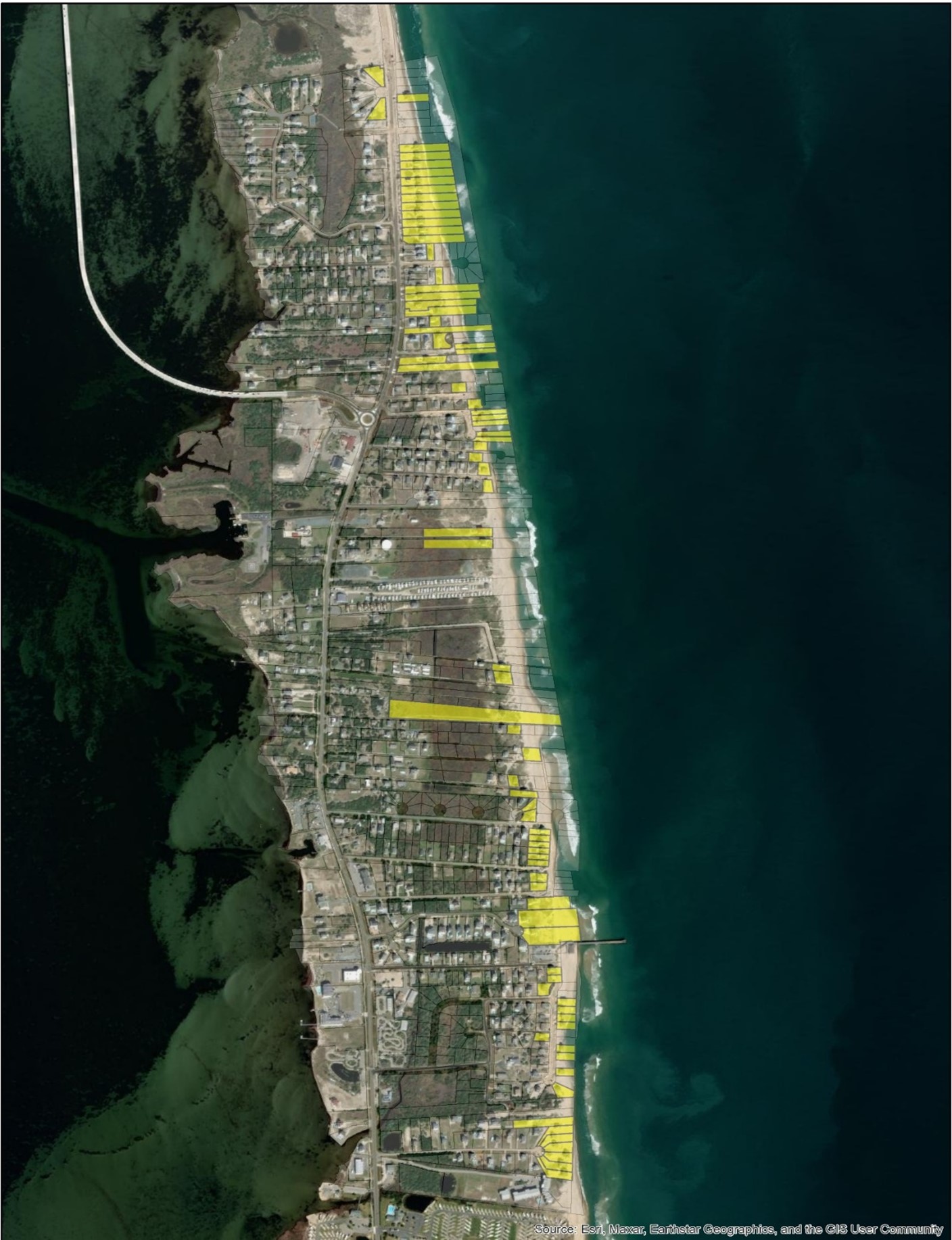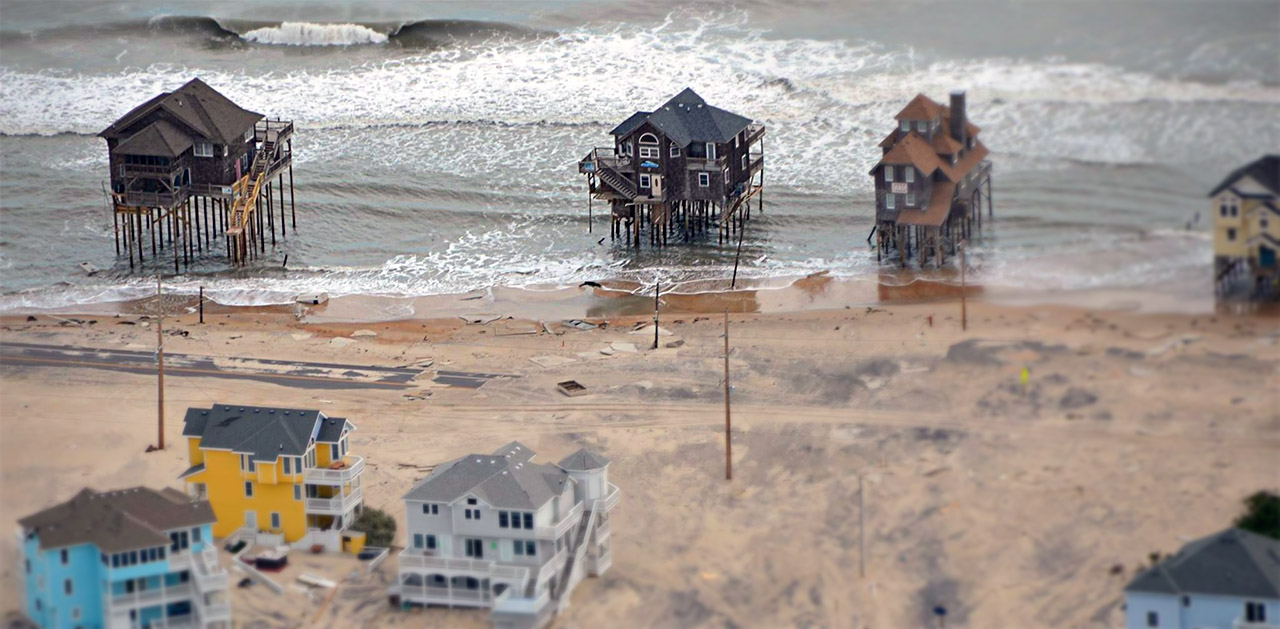Program for the Study of Developed Shorelines
Science. Policy. Education. Outreach. Coastal.
The Potential Cost/Benefits of Buyouts in Rodanthe, North Carolina
The oceanfront shoreline of Rodanthe, North Carolina has one of the highest erosion rates on the U.S. East Coast (recently upwards of 20 feet per year). Many homes that were initially constructed well back from the beach are now at risk of constant flooding and imminent collapse. A typical response to this erosion in Dare County (and most coastal communities) would be the implementation of a beach nourishment project. It is unclear whether this is practical for Rodanthe, as the geologic setting is problematic. With such high erosion rates, episodes of renourishment would be frequent, driving up costs significantly. A recently released report entitled: Rodanthe Sand Needs Assessment Dare County, North Carolina (Coastal Science and Engineering, 2023) recommends an initial project at a cost of approximately $40 million. Costs for long-term beach maintenance bring the total to about $120 million over the next 15 years. This assumes that the sand from each nourishment placement will last around 5 years, which may be a bit of a stretch along this shoreline. The CSE study indicates there could be modest cost savings from the construction of groins along this shoreline. We did not consider this analysis since groins are not permitted by law on the North Carolina oceanfront due to the inevitable downdrift harm caused by the interruption of longshore sediment transport. Even with beach nourishment, there will be periods of time between sand placement episodes when the beach will narrow, and the most exposed homes will be in the waves.
On the other hand, doing nothing has resulted in numerous high-profile incidents of homes collapsing into the sea, while septic tanks are exhumed and broken open. These events cause both environmental harm and a risk to public safety and health (the intertidal beach in this area is a part of Cape Hatteras National Seashore). Clearly, doing nothing is the worst option.

One alternative solution to nourishment is to implement a buyout plan for highly exposed properties. Buyouts are rarely a first choice within coastal communities for a variety of reasons, both practical and emotional. Property owners must be interested in selling, and it can be difficult to negotiate a price. Unlike nourishment, buyouts provide a longer-term solution to erosion, allow for a continuous beach over many years, and eliminate the environmental and public safety hazards associated with collapsing homes. In some areas, the U.S. Army Corps of Engineers has carried out buyouts in conjunction with beach nourishment to allow for the construction of protective dunes.
To compare the costs of a possible buyout to the costs of beach nourishment in Rodanthe, we conducted a simple analysis to identify and estimate the value of highly exposed oceanfront properties. The criteria we used identified 80 oceanfront parcels with a structure within 300 feet of the high-tide shoreline, over an alongshore area that is roughly the same footprint as the potential nourishment project. Assessed tax value was used to represent the current value for these properties. Detailed methods for property selection and fiscal analysis are described in the following sections of this document.
Results from this analysis estimate that it will cost nearly $43 million to buyout all selected properties (at currently assessed value), and by removing these properties Rodanthe will likely have a viable beach for 15-25 years. Only one of the properties appears to be a primary residence. A number of parcels have lots that are deep enough to move the structure back (outside our buffer), at lower cost than buying the property and removing it.
The loss of tax revenue is a common concern expressed about buyouts. The 80 selected properties generated $171,068 of county property tax revenue in fiscal year 2023, which is only 0.25% of the Dare County tax base. The total lost revenue over 30 years could be $7 – $10 million based on the very conservative scenarios outlined in the table below. For example, we assume all 80 properties will still be around in 30 years. This is unlikely. Some of this loss will likely be offset by the additional tax revenue resulting from the increase in value of the remaining properties (e.g., certain second-row homes become oceanfront).
In this simple analysis the beach nourishment costs are significantly higher (roughly 3 times higher) over the next 15 years than buying the properties at current tax value. Of course, predicting the costs for shoreline protection and/or property acquisition over the next couple of decades is not an exact science. The ultimate costs depend on factors such as sea-level rise, storms, and market forces for high-risk properties. An advantage of buyouts is that the process could be piecemealed. A buyout plan could happen gradually, targeting the highest exposure properties and willing sellers first (likely the most practical approach). The initial costs would be significantly smaller than beach nourishment which will require substantial expenditure up front. In addition, buyouts could be initiated immediately, whereas beach nourishment will require substantial planning and permitting.
A more gradual buyout process may cost less than the estimated $43 million, as the market value of properties will likely decrease as erosion begins to threaten homes. While this study does not prioritize the order of acquisition, further analysis could certainly provide the data to do so.
The primary advantage of beach nourishment is that it may preserve the existing oceanfront properties for the next decade or so, along with their tax revenues. In addition, Dare County has experience implementing beach nourishment projects in a professional way. A disadvantage is that there will be multiple episodes of nourishment required over this interval, separated by periods of time when the beach is narrow, and homes are once again highly exposed. Buyouts would allow for a continuous, wide beach for a longer period of time.
We understand that there are obstacles to both buyouts and beach nourishment. This study is not intended to recommend either approach, but provides additional data that could inform the discussion of possible solutions. Looking at this narrowly, from a cost perspective, it is clear that buyouts are not a crazy idea. A main reason that we conduct an analysis like this is because no one else does. We feel very strongly that, whatever is ultimately decided, projects funded with public funds must examine the costs/benefits of managed retreat through buyouts as one viable option. This is abundantly clear: the status quo (taking no action) is the least favorable and most environmentally damaging option.

Program for the Study of Developed Shorelines
Old Student Union
Western Carolina University
Cullowhee, NC 28723

